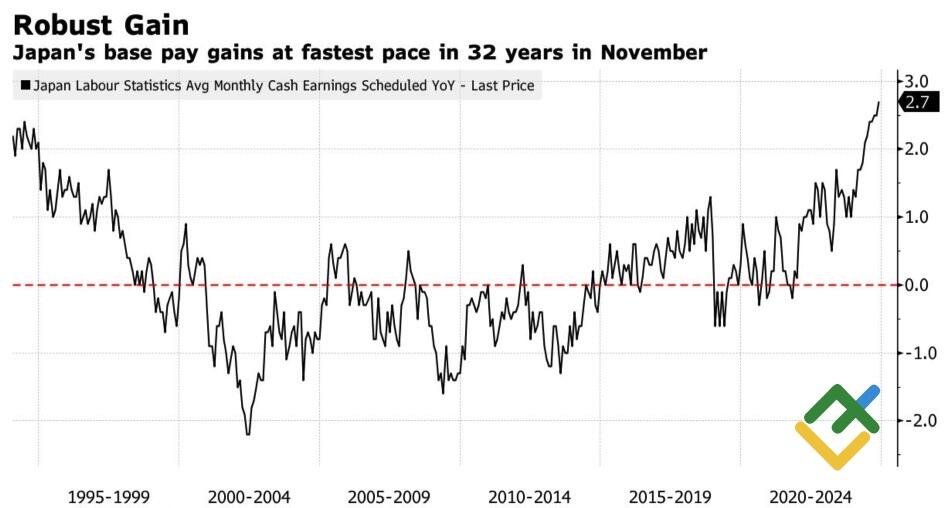
The USDJPY pair has declined in response to robust US employment statistics for December, deviating from the principles of fundamental analysis. The US dollar strengthened against major world currencies, with the exception of the yen. Let’s discuss this topic and make a trading plan.
The article covers the following subjects:
Major Takeaways
- Strong US employment data has strengthened the yen.
- Tokyo prefers to keep silence about currency interventions.
- The Bank of Japan is unlikely to increase the overnight rate before March.
- A pullback in the USDJPY pair is an opportunity to open long trades with the target at 160 and higher.
Weekly Fundamental Forecast for Yen
In anticipation of the US labor market report, the Forex market widely expected that Japan would return to currency interventions, aligning them with this significant event on the economic calendar. The yen’s response to the robust job growth and rising Treasury yields suggests that the Japanese currency was a sought-after asset. This could be perceived as a deviation from the BOJ’s usual strategy, which was previously implemented during periods of a weakening US dollar. However, this time, there seems to be a different situation.
As the USDJPY exchange rate increased, markets speculated about potential currency interventions, drawing parallels to past events. Tokyo spent approximately $155 billion between 2022 and 2024, asserting that the pair’s 10-yen shift was rapid and the 4% rally in two weeks was anomalous and not indicative of the fundamental backdrop. With these statements from government officials in mind, Bloomberg has proposed a scenario in which the US dollar’s approach to ¥159 and ¥162 might have prompted the BoJ to consider selling the greenback.
Yen Performance in Intervention Zone
Source: Bloomberg.
It appears that this scenario did occur. USDJPY quotes almost touched the 159 mark before experiencing a decline, driven by robust US labor market statistics. These figures were observed during the announcement of the results of the December Fed meeting. At that time, the FOMC’s updated rate forecasts boosted the US dollar against major world currencies.
The USDJPY movement is somewhat unusual. The pair tends to respond sensitively to US Treasury bond yields, which, according to most forecasts, should have reinforced the uptrend. However, there has been a pullback. It appears that this pullback was not significantly influenced by the re-emergence of discussions about a possible increase in the overnight rate in January, following the notable rise in Japan’s base wage to 2.7%, marking a 32-year high. As a result, nominal labor wage growth reached 3%, surpassing the Bloomberg experts’ forecast of 2.7%.
Base Average Monthly Cash Earnings in Japan
Source: Bloomberg.
It appears that labor shortages have given unions a certain degree of influence over the terms of employment, with wages projected to rise by at least 5% in 2025, following a 5.1% increase in 2024. The Bank of Japan is able to continue the normalization cycle due to the indicator. However, in December, Kazuo Ueda expressed the need for clarity on not only Japan’s labor market but also the economic policies of the new US president. Therefore, March could be a more suitable time for an overnight rate hike.
Weekly USDJPY Trading Plan
It seems that the intervention did occur. If not, the USDJPY pair could have surged as high as 160. However, the intervention will unlikely reverse the current uptrend, as it requires a weaker US dollar. Since the greenback remains strong, the pullback allows traders to open long trades at an attractive price with the previously outlined targets of 160–160.5.
This forecast is based on the analysis of fundamental factors, including official statements from financial institutions and regulators, various geopolitical and economic developments, and statistical data. Historical market data are also considered.
Price chart of USDJPY in real time mode
The content of this article reflects the author’s opinion and does not necessarily reflect the official position of LiteFinance. The material published on this page is provided for informational purposes only and should not be considered as the provision of investment advice for the purposes of Directive 2004/39/EC.
{{value}} ( {{count}} {{title}} )
This post is originally published on LITEFINANCE.






